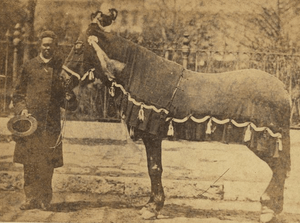Old Bob
Old Bob or Old Robin (c. 1849 – unknown) was a driving horse used by Abraham Lincoln during the period prior to his presidency of the United States. He later participated in Lincoln's funeral. Old Bob's exact fate and date of death are unknown; he was sold to drayman John Flynn by Lincoln in 1860.
 Old Bob caparisoned in a mourning blanket at Abraham Lincoln's funeral | |
| Other name(s) | Old Robin (unconfirmed) |
|---|---|
| Species | Equus ferus |
| Sex | Male |
| Born | c. 1849 |
| Occupation | Driving horse |
| Appearance | Bay |
Name
There is confusion about whether the name of the horse was "Old Bob" or "Old Robin", though "Old Bob" is the name most widely used. It is believed Lincoln named the horse "Old Bob" to differentiate the animal from his son, Robert Lincoln ("young Bob").[1][2]
Early life
Lincoln acquired Old Bob while practicing law in Springfield, Illinois, and used the animal as a carriage horse when traveling on his circuit in areas unconnected by the railroad.[2] Old Bob replaced Lincoln's other horse, Old Buck, who had become too old for regular use. He was stabled in a barn behind the Lincoln home with another Lincoln-owned horse, Old Tom.[3]
Following his 1860 election as President of the United States, and prior to his subsequent move to Washington, D.C., Lincoln sold Old Bob to John Flynn, a Springfield drayman.[4]
By 1865 Old Bob had been put to pasture, however, on April 4 of that year he was brought out of retirement to participate in a parade in Springfield celebrating the capitulation of the Confederate States capital city of Richmond, Virginia. He was coated in a red, white and blue blanket for the occasion.[3]
Lincoln funeral and later life

Following the assassination of Abraham Lincoln, Old Bob was again brought out of retirement. During the cortège preceding the funeral in Springfield, Old Bob was caparisoned in a black mourning blanket trimmed with silver fringe and tassels. Henry Brown, an African Methodist Episcopal minister and friend of the Lincoln family, led Old Bob, whose spot in the procession was immediately behind the hearse and in front of the carriage carrying Robert Todd Lincoln.[5] It has been said that Robert Lincoln and Old Bob were the only members of Lincoln's family present at his funeral.[3][lower-alpha 1]
After the funeral, it is believed there were several attempts to acquire the horse by showmen who wished to put it on exhibition, but that John Flynn declined offers to sell the animal. Old Bob's ultimate fate is unknown.[3]
Legacy
A statue by Ivan Schwartz, Stuart Williamson and Jiwoong Cheh depicting Lincoln with a horse modeled on Old Bob was installed in 2008 at President Lincoln's Cottage at the Soldiers' Home in Washington, D.C.[7][8] The sculptors studied a photograph of Old Bob in designing the statue, which depicts an American Standardbred saddled for riding.[7]
During the 2015 sesquicentennial observances of Lincoln's death, the cortège was restaged in Springfield. Glory, a horse used by Daniel Day-Lewis in the 2012 film Lincoln, was used to represent Old Bob.[9] The same year, Bunker Hill Publishing published a children's book by Trudy Krisher, An Affectionate Farewell: The Story of Old Abe and Old Bob.[10][11]
See also
- Abraham Lincoln's hearse
- Black Jack – a U.S. Army horse caparisoned for the state funerals of John F. Kennedy, Herbert Hoover, and Lyndon Johnson
- Riderless horse
Notes
- Mary Lincoln became hysterical following the assassination. Unable to participate in the funeral observances, she remained cloistered at the White House with Tad Lincoln throughout.[6][3]
References
- Wynalda, Stephen (2010). 366 Days in Abraham Lincoln's Presidency: The Private, Political, and Military Decisions of America's Greatest President. Skyhorse Publishing. p. 25. ISBN 1602399948.
- Armistead, Gene (2013). Horses and Mules in the Civil War. McFarland. p. 158. ISBN 1476602379.
- Algeo, Matthew (2015). Abe & Fido: Lincoln's Love of Animals and the Touching Story of His Favorite Canine Companion. Chicago Review Press. ISBN 1556523831.
- Mansch, Larry (2005). Abraham Lincoln, President-Elect: The Four Critical Months from Election to Inauguration. McFarland. p. 124. ISBN 0786431024.
- Steers, Edward (2005). Blood on the Moon: The Assassination of Abraham Lincoln. University Press of Kentucky. p. 290. ISBN 0813191513.
- Wead, Doug (2004). All the Presidents' Children. Simon & Schuster. pp. 92–95.
- "Honest Abe and Old Bob". Washington Times. August 17, 2008. Retrieved February 23, 2017.
- "Bronze statue of Abraham Lincoln and his horse at the Lincoln Summer Home located on the grounds of the Armed Forces Retirement Home in northwest Washington, D.C." Prints and Photographs Online Catalog. Library of Congress. Retrieved February 23, 2017.
- "Illinois will relive Lincoln's assassination and funeral". Los Angeles Times. April 10, 2015. Retrieved February 24, 2017.
- "An Affectionate Farewell: The Story of Old Abe and Old Bob". Publishers Weekly. Retrieved February 24, 2017.
- Dettro, Chris (April 10, 2015). "Events abound leading up to Lincoln funeral re-enactment". State Journal-Register. Retrieved February 24, 2017.